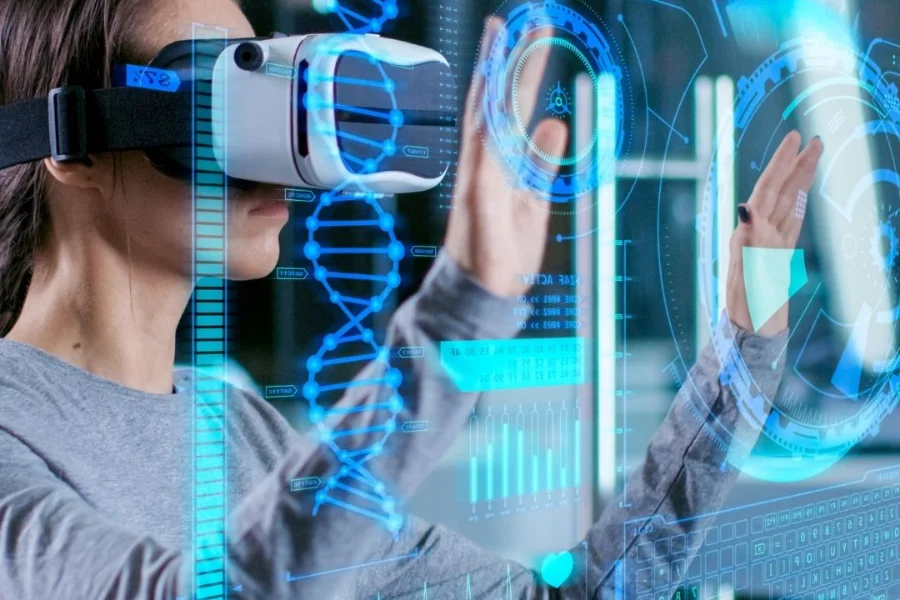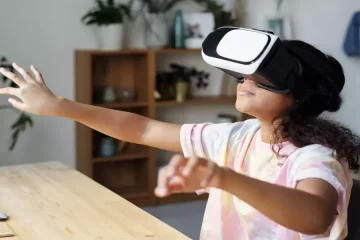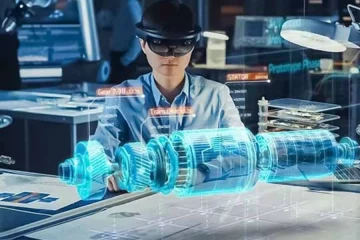The Future is Here: Exploring the Latest Innovations in Electronics

Innovations in Electronics | Mykaba
From self-driving cars to AI-powered personal assistants, the world of electronics is constantly evolving, and the future is already here. With the latest innovations changing the way we live our lives, it’s an exciting time to explore the possibilities of what’s to come. From wearable technology to smart homes, the latest advancements are designed to make our lives easier, more efficient, and more connected than ever before. Whether you’re a tech enthusiast or simply curious about what’s on the horizon, there’s no denying the impact that electronics will have on our future. In this article, we’ll take a closer look at the latest innovations in electronics and explore how they’re changing the game in exciting new ways. So buckle up and get ready to explore the cutting-edge world of electronics. The future is here, and it’s more exciting than ever before!
Artificial Intelligence (AI) and Machine Learning
Artificial Intelligence (AI) and Machine Learning are transforming the electronics industry. AI, in particular, has the potential to revolutionize the way we live our lives. AI-powered personal assistants, such as Siri and Alexa, are already making our lives easier by helping us manage our schedules, set reminders, and answer our questions. But AI has the potential to do so much more. In the future, AI could help us make better decisions about everything from our health to our finances.
Machine Learning, on the other hand, is helping us make sense of the vast amounts of data that are generated every day. Machine Learning algorithms can identify patterns in data that would be impossible for humans to detect. This has huge implications for everything from medical research to predictive maintenance in manufacturing.
But AI and Machine Learning also raise important ethical questions. As we rely more and more on machines to make decisions for us, how do we ensure that those decisions are fair and unbiased? And how do we prevent the misuse of AI for nefarious purposes?
Internet of Things (IoT)
The Internet of Things (IoT) is another area where electronics are transforming our lives. The idea behind IoT is to connect everyday devices to the internet so that they can communicate with each other and with us. This has huge implications for everything from healthcare to transportation.
One example of IoT in action is smart homes. Smart homes are equipped with sensors and connected devices that allow homeowners to control everything from their thermostats to their security systems from their smartphones. This not only makes homes more comfortable and convenient but also more energy-efficient.
IoT also has the potential to revolutionize healthcare. Connected medical devices can monitor patients remotely, allowing doctors to keep track of their health in real-time. This has the potential to improve patient outcomes while also reducing healthcare costs.
But as with AI and Machine Learning, IoT also raises important security and privacy concerns. As more and more devices are connected to the internet, the risk of cyber attacks increases. And as more data is collected about us, the risk of that data being misused also increases.
Virtual and Augmented Reality (VR/AR)
Virtual and Augmented Reality (VR/AR) are transforming the way we experience the world around us. VR allows us to immerse ourselves in virtual environments, while AR overlays digital information on the real world. Both technologies have huge implications for everything from entertainment to education.
One example of VR in action is virtual tourism. With VR headsets, users can explore destinations around the world without ever leaving their homes. This not only makes travel more accessible but also more sustainable.
AR, on the other hand, has huge potential in fields such as education and healthcare. AR apps can overlay information on the real world, allowing students and doctors to see things in new and innovative ways.
But as with any new technology, VR and AR also raise important ethical questions. For example, how do we ensure that these technologies are accessible to everyone, regardless of their socioeconomic status? And how do we ensure that they’re not used to manipulate or deceive people?
Foldable and Flexible Displays
Foldable and Flexible Displays are changing the way we interact with our devices. These displays are made from materials that are flexible enough to bend without breaking. This allows for devices that can be folded up and put in your pocket, or even worn on your wrist like a watch.
One example of a foldable display in action is the Samsung Galaxy Fold. This smartphone has a foldable display that allows users to switch between a phone and a tablet-sized screen. This not only makes the device more versatile but also more portable.
Flexible displays also have huge implications for wearables. Devices such as smartwatches and fitness trackers could be made even more comfortable and convenient with flexible displays.
But as with any new technology, there are also challenges to overcome. For example, how do we ensure that foldable displays are durable enough to withstand everyday use? And how do we ensure that they’re affordable enough to be accessible to everyone?
5G Technology
5G Technology is the next generation of wireless communication. It promises faster download and upload speeds, lower latency, and more reliable connections. This has huge implications for everything from entertainment to healthcare.
One example of 5G in action is remote surgery. With 5G, doctors can perform surgeries remotely, with the help of robots and other connected devices. This not only makes surgeries more accessible but also more efficient.
5G also has huge implications for entertainment. With faster download speeds, users can stream high-quality video content without buffering or lag.
But as with any new technology, 5G also raises important questions about safety and security. As more devices are connected to the internet, the risk of cyber attacks increases. And as more data is collected about us, the risk of that data being misused also increases.
Drones and Autonomous Vehicles
Drones and Autonomous Vehicles are changing the way we think about transportation. Drones are being used for everything from delivering packages to monitoring wildlife. Autonomous Vehicles, on the other hand, have the potential to revolutionize the way we get around.
One example of an Autonomous Vehicle in action is the Tesla Model S. This car has a number of autonomous features, including the ability to park itself and change lanes on the highway. This not only makes driving more convenient but also safer.
Drones also have huge implications for industries such as agriculture and construction. With drones, farmers can monitor their crops and construction workers can survey job sites from above.
But as with any new technology, drones and autonomous vehicles also raise important questions about safety and security. How do we ensure that these devices are safe to operate in public spaces? And how do we ensure that they’re not used for nefarious purposes?
Wearable Technology
Wearable Technology is another area where electronics are transforming our lives. Wearable devices such as smartwatches, fitness trackers, and even smart clothing are becoming more and more popular.
One example of wearable technology in action is the Apple Watch. This device not only tells time but also tracks your fitness, monitors your heart rate, and even allows you to make phone calls and send messages.
Wearable technology also has huge implications for healthcare. Devices such as glucose monitors and ECG monitors can help patients manage chronic conditions more effectively.
But as with any new technology, wearable devices also raise important questions about privacy and security. As more data is collected about us, the risk of that data being misused also increases.
Smart Homes and Cities
Smart Homes and Cities are transforming the way we live our lives. Smart homes are equipped with sensors and connected devices that allow homeowners to control everything from their thermostats to their security systems from their smartphones. Smart cities, on the other hand, use technology to improve everything from traffic flow to public safety.
One example of a smart city in action is Singapore. This city-state has implemented a number of smart technologies, including traffic sensors that improve traffic flow and a network of surveillance cameras that help keep the city safe.
Smart homes also have huge implications for energy efficiency. By monitoring energy usage and adjusting settings accordingly, smart homes can help reduce energy waste and save homeowners money on their utility bills.
But as with any new technology, smart homes and cities also raise important questions about privacy and security. As more data is collected about us, the risk of that data being misused also increases. And as cities become more connected, the risk of cyber attacks increases as well.
Future of Electronics
The future of electronics is exciting and full of possibilities. From AI-powered personal assistants to smart cities, the latest innovations are designed to make our lives easier, more efficient, and more connected than ever before.
One area where the future of electronics is particularly exciting is healthcare. Connected devices and AI-powered diagnostics have the potential to revolutionize the way we think about healthcare, making it more personalized, efficient, and effective.
Another area where the future of electronics is exciting is transportation. With drones and autonomous vehicles, we could see a future where transportation is not only more efficient but also safer and more environmentally friendly.
But as with any new technology, there are challenges to overcome. Ensuring that these technologies are accessible to everyone, regardless of their socioeconomic status, is one of the biggest challenges we face. And ensuring that they’re used ethically and responsibly is another challenge that will require careful consideration and planning.
Conclusion
The world of electronics is constantly evolving, and the future is already here. From AI-powered personal assistants to smart cities, the latest innovations are designed to make our lives easier, more efficient, and more connected than ever before. But as with any new technology, there are challenges to overcome. Ensuring that these technologies are accessible to everyone and used ethically and responsibly will require careful consideration and planning. As we continue to explore the possibilities of what’s to come, one thing is certain: the future of electronics is exciting and full of possibilities.









